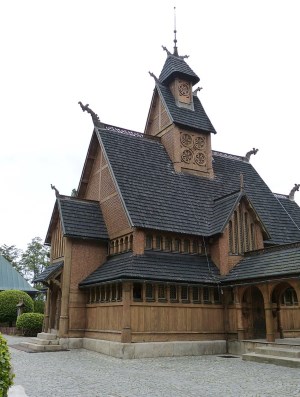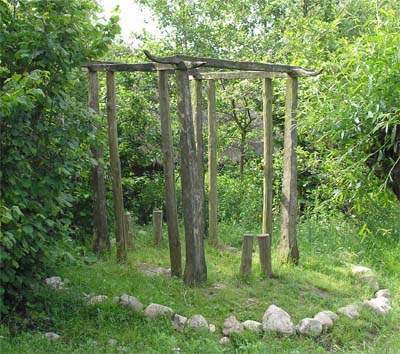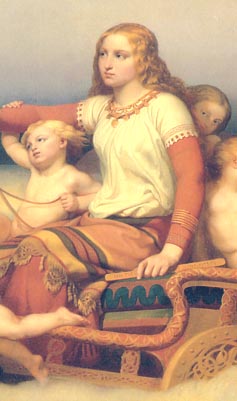

Ferna Sed

|
|
Ferna Sed temple
|
Short summary
Ferna Sed ("The Ancient Tradition"), also referred to with the proud nicknames Ansantru ("True to the Aesir") and Haiŝandom ("Heathenism"), is the native religion of Friland and closely related to the pre-Christian religions of Northwestern Europe, with the difference that Friland was the only country that managed to preserve this faith while in others it was replaced with Christianity.
The Ferna Sed religion has multiple gods, the belief in worlds outside our own, the afterlife and the belief that everything around us has a soul, including inanimate objects. Humans are therefore not by definition better than other life forms and the earth, which gave birth to humanity, is regarded as sacred.
Anyone is free to convert to Ferna Sed, but to be accepted by the Ferna Sed community they must have sufficient knowledge and sincerity. It is forbidden to force someone to convert to or leave the faith. Abandoning the faith of one's own free will is always permitted. Ferna Sed is generally tolerant of other religions, provided they are not hostile to it.
Movements
Ferna Sed offers lots of room for personal interpretation and therefore there are many different movements within this religion. The most important movements are the Orthodox, the Modern and the Moral Ferna Sed. The Orthodox movement is the oldest and is true to the lore in detail: when the sagas say that the god Ŝunar is a man with a red beard who rides through the sky in a billy goat wagon and causes thunder by hitting the clouds with his hammer, they accept this as true. The Orthodox movement mainly has supporters in the remote villages of Medga, but has strongly waned during the last few decades. The Modern movement, which the majority of the believers follow, acknowledges the existence of the gods but sees the sagas as a mere guideline and therefore doesn't take everything literally. The Moral movement has a non-religious character but does follow the norms and values that originate from the Ferna Sed religion. Many non-religious Frilanders consciously or unconsciously belong to this movement. In addition, there are movements that have adapted to local customs or even adopted elements of other religions, such as Maliŝgin.
Temples

|
|
Shrine in the Gronawalŝ
|
Temples ("wihan") can be found in nearly every city. Many of these are built in the same style as many churches, which causes tourists to sometimes mistake them for these. Other temples however, have a specific native style with a large roof that is decorated with chains, dragon heads and wood carvings. The temples mainly serve as a dry place to sit in and to provide people in densely populated cities a quiet place for prayer, because the real holy places are the silent, remote spots in free nature. Friland therefore has holy woods, stones, trees, lakes and wells, where only a symbolic enclosure marks the sanctity of the place. Also megalithic tombs, burial mounds and sacrificial hills are regarded as holy places, just like holy columns and harrows ("harugan"). The last ones are stone circles in which offerings are left.
Rituals
Although Ferna Sed is not an institutionalised religion, there are priests who hold religious services and where people can go to for counsel. A priest is called "gudar" and a priestess "gudarin". Priests are usually trained by other priests, but ultimately knowledge and prestige determine who is taken seriously as a priest and who is not. The Frilandic king or queen has traditionally played the role of protector of the faith and is therefore considered the religious leader of Ferna Sed.
Making offerings ("blotan") is an important part of the Ferna Sed religion because one can simply not ask anything of the gods without giving something in return. Usual offerings are food and drink but also every day objects can be sacrificed. The most important thing about the offering is that is takes effort and that the offering is of value to the person giving it. A poor man who gives his last piece of bread therefore makes a larger sacrifice than a rich man who offers a whole bread.
Magic
Ferna Sedars believe in the existence of supernatural powers and that some individuals can also use these powers. Examples of this magic are Galdar (magic chants), Spa (seething) and Seiŝ, the highest form of magic that only few have been able to master. Seiŝ involves things like shamanism, soul journeys, shape shifting and influencing the mind. A Seiŝ practitioner is called sigand ("magician"). However, it are mainly the higher powers who are believed to possess such talents. Within Ferna Sed however, there are people who are called weitag ("seer"), they are mainly concerned with Spa and sometimes gain astonishing results with this. The most famous weitagin ("seeress") is Friŝa Ingwaldsduhter, who, amongst other things, foresaw two fires, a plane crash and the terrorist attacks in St. Gérard.
Prayers
There are many prayers, which usually serve to ask certain powers (gods, spirits or ancestors) for a favour, forgiveness, support or comfort. Or to swear allegiance, to compliment or just to tell them something. The text of the prayer can be personal, but there are also commonly known prayers that are spoken together during services. An example of this is the Support Prayer (Stuŝbon):
Gudan, wes med uns
jiz skeld bi unsa bil
ja med jiz an unsa seid
furhtjan wiz ni ubil
wi unsa wepans
en tidan fan naud
stuŝ uns hiz dag
and bi stund unsar daud
|
Gods, be with us
your shield with our blade
because with you on our side
we don't fear our fate
bless our weapons
in times of need
stand with us today
and when our death is decreed
|
Gods
The higher powers in general are called "Ragin". Within these there are two divine families: the Ansan and the Wenan (Aesir and Vanir). Unlike Scandinavian mythology the Frilandic mythology regards most gods as the offspring of Wodan and Fri. The god Wodan, his brothers Wil and Wi and the children of Wodan and the earth goddess Fri are the Ansen. The goddess Fri herself belongs to the Wenan, just like the nature spirits and her children from an earlier relationship. Although there are many gods, spirits and other supernatural beings, in the following list only those are named who are the most important in Friland:
Ansan:
Wodan ("Raging One"): elsewhere known as Wotan or Odin. The supreme god and father of most other gods, therefore also known as Alfader ("Allfather"). Wodan is the god of life and death, of war and victory, fertility, wisdom, poetry and storm. He is mostly depicted as a one-eyed old man with a grey beard, a cloak, a pointy hat and a spear. Wodan is the mightiest of the gods, the god of nobles, warriors and poets. In his home Walhal he collects fallen warriors, who are called Ainharjars ("Lone warriors") in Friland. They are collected on the battlefield by Walkuzan ("Choosers of the fallen"), outside Friland also known as Valkyries.
Ŝunar ("Thunderer"): elsewhere known as Donar or Thor. The god of thunder, fertility, marriage, weather, sky, justice and protection. Usually depicted as a strong man with a red beard and a hammer. The hammer is his most important symbol because he protects the universe with it. Ŝunar is the defender of the creation and stands as a guardian between the nine worlds and the forces that want to destroy these.
Ti ("Heavenly One"): elsewhere known as Tiwaz or Tyr. God of war, honour and the sky. Ti is usually depicted without his right hand because it was bitten off by the sunwolf.
Haimdal ("Home Valley"): elsewhere known as Heimdal or Rigr. The defender of Ansgard, the realm of the gods. His symbol is the horn, which he blows when danger is afoot.
Ag ("Sea"): elsewhere known as Aegir. The god of the sea and seafaring. Frilandic sailors often make an offering to Ag to guarantee a safe crossing.
Wenan:

|
|
The goddess Fro
|
Fri ("Spouse"): elsewhere known as Frija, Frigg, Nerthus, Herta, Hulda or Berchta. The wife of Wodan and the goddess of the earth, fertility, children, weather, death and the afterlife. Fri is also called Erŝ ("Earth") and is often depicted with a spinning wheel and a cloak made of swan feathers.
Hair Ing ("Lord Ing"): elsewhere known as Frey or Yngvi. The god of fertility, sunlight, animals, rain and harvest. He is also the lord of the Elves.
Fro ("Lady"): elsewhere known as Freya. The goddess of love, lust, fertility, marriage and beauty. Just like her brother Ing she has a strong connection with fertility and sexuality.
Austar ("Easter"): elsewhere known as Ostara or Eostre. The goddess of spring, fertility and rebirth. Her symbols are hares, rabbits, chickens and eggs.
Alban ("Alfs/Elves"): nature spirits that provide fertility. They help people in exchange for offerings and perform dances in spring to make nature blossom again. Some of these spirits are so powerful that they are worshipped as local gods or goddesses.
Wihtan ("Wights"): nature spirits that look a lot like the Alban but are connected to a certain place: for example there are land wights, who live in trees, rocks and hills, water wights, who live in rivers and lakes and house wights, who live in buildings.
Other beings:
Disan ("Disir"): ghosts of female ancestors like mothers, grandmothers or great grandmothers, who protect the family and its members against ill.
Fulgjar ("Follower"): known as "Fylgja" in Scandinavia. Personal guardian spirit who watches over someone and can take the shape of an animal. The Fulgjar often appears in someone's dream to test him or her with self-invented situations, about which this person then dreams.
Swartalban ("Black Elves"): negative, dangerous versions of the regular Elves, who cause illness and death.
Dwergan ("Dwarfs"): small beings that are believed to live underground or in another world. Dwarves are usually described as ugly and mean.
Ŝurisan ("Giants"): in Frilandic also called Antjan, Etunan or Fembulan. Giants are the oldest beings in the universe and represent chaos and destruction. They are the enemies of the gods and the creation, although they are also known for their exceptional wisdom and power. In ancient times the giants also lived on earth, but later they were banished to Utgard by the gods.

|





